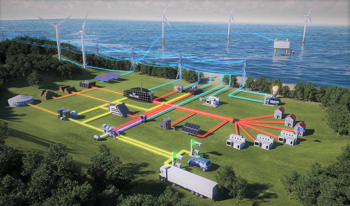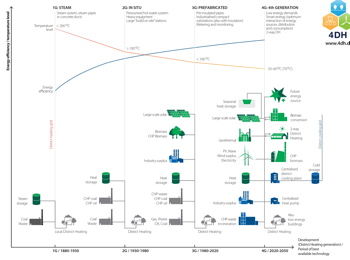4G heat networks tackle fuel poverty

Fourth generation heat networks have a key role to play in reducing fuel poverty in the UK,as well as cutting overall carbon emissions, says Katerina Nika
Fuel poverty is a widespread socioeconomic issue across the UK, driven by three key factors: The energy efficiency of the property; the cost of energy; and the income of the household.
Providing financial support to households in fuel poverty does not address the root cause. We must address energy efficiency and fuel costs, and heat networks have a key role to play. On average, a heat network user will pay £100 less on their annual heat bill compared to non-heat network users. However, BSRIA estimates that less than 2% of the UK’s total housing stock is currently connected to a heat network or central plant system.
To clarify the terminology, a heat network distributes hot water or steam through insulated pipes to provide space heating and domestic hot water to a number of apartments, a block, a number of different buildings, or a combination of all these.
A heat network that supplies heat to a number of apartments or a small number of blocks from a local energy centre, is described as a block heat network. A heat network that utilizes energy produced in large central plants and supplies a whole area is a district heating system.
The latest generation of heat networks, known as fourth generation or 4G, uses low carbon heat sources as well as more traditional technologies and has the capability to integrate smart electricity, thermal and gas grids and enable the wider use of renewable energy. Crucially, true 4G heat networks adopt an ‘open source’ approach to heat sources, with the inherent flexibility to exploit the best heat and power sources available, both now and into the long-term future.
 |
|
4G heat networks integrate smart electricity, thermal and gas grids as well as renewables available locally |
Where CHP is included in the mix of heat sources, it will also generate low cost electrical power that can be used in the building(s) to reduce the use of more expensive mains electricity. There are also savings on operation and maintenance costs through economies of scale, compared to traditional heat supply arrangements.
For heat networks to play a more pivotal role in tackling fuel poverty there is a strong argument for shifting focus from high profile, city-wide district heating schemes to smaller block heat networks that are easier and more commercially viable to implement.
A block-level approach
Large district heating schemes require extensive infrastructure work, resulting in very high costs and major disruption. Many proposed schemes are never implemented because of this.
Block heat networks, on the other hand, require only the installation of heating- and cold -water pipes in the building, creation of an energy centre (typically on the same site) and provision of heat interface units in each space being heated.
Block heat networks can therefore be seen as ‘low hanging fruit’ – commercially viable and easy to implement, even in existing buildings, where much of the UK’s fuel poverty is centred. Such relatively small schemes may integrate with other block heat networks to create a wider district heating system.
There are around 5,500 district-scale and 11,500 communal-scale heat networks in the UK, providing 10TWh per year (around 2% of UK buildings’ heat demand). In order for the UK to meet its 2050 carbon targets, it is estimated that around 18% of UK heat will need to come from heat networks.
Designing for the future
To achieve this, it is vital to move to 4G heat networks which can use whatever energy sources are available locally – the moredistant the energy source, the higher the distribution losses and cost of heat.
 |
|
Four generations of heat network |
It’s also important that the buildings are designed to exploit these heat sources using 4G heat networks. To optimize the performance, alongside the lower operating temperatures, optimum thermal efficiency of the building fabric is required. They also need to incorporate sufficient energy storage to manage variable renewable energy sources, with hot water being the most costeffective form of energy storage. Designs should therefore make provision for considerably higher volumes of stored hot water than would traditionally be the case.
The buildings are also ‘futureproofed’ against changes made at the energy centre, enabling the energy centre to be upgraded to new heat sources whenever appropriate with minimum cost and disruption.
Heat networks have the potential to make a difference in the battle against fuel poverty. However, if they are to address socio-economic considerations as well as those of carbon emissions, they need to adopt the 4G philosophy.
To that end, block heat networks offer the best value with the greatest viability – along with the flexibility to mix low carbon heat sources, and the potential to extend schemes, at an affordable pace, to form wider district heating systems.
Katerina Nika is marketing communications manager with SAV Systems







